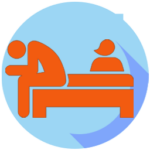Imagine falling asleep suddenly and uncontrollably in the middle of a conversation, while driving, or during a crucial meeting. For individuals with narcolepsy, this is not a mere hypothetical scenario but an unfortunate reality. Narcolepsy is a complex neurological disorder that affects the sleep-wake cycle, leading to a range of symptoms that disrupt daily life. In this blog, we’ll explore the fascinating yet challenging world of narcolepsy, its symptoms, causes, diagnosis, and treatment options.
Understanding Narcolepsy
Narcolepsy is a chronic sleep disorder characterized by excessive daytime sleepiness (EDS), which manifests as an irresistible urge to sleep during the day. While many people experience fatigue from time to time, narcoleptics face a unique and overwhelming need to sleep, often with little to no warning. This can occur even after a full night’s sleep.
Key Symptoms
- Excessive Daytime Sleepiness (EDS): The hallmark symptom of narcolepsy, EDS, can severely impact daily activities, making it difficult to stay awake and alert.
- Cataplexy: Narcolepsy is often accompanied by cataplexy, which is a sudden loss of muscle tone triggered by strong emotions such as laughter, surprise, or anger. This can lead to weakness in various muscle groups, making individuals temporarily unable to move.
- Sleep Paralysis: People with narcolepsy may experience sleep paralysis, a terrifying phenomenon where they temporarily cannot move or speak while falling asleep or waking up.
- Hallucinations: Vivid and often disturbing dream-like hallucinations can occur when falling asleep or waking up, a phenomenon known as hypnagogic or hypnopompic hallucinations.
- Disrupted Nighttime Sleep: Narcolepsy can also affect nighttime sleep, leading to frequent awakenings, restless sleep, and vivid dreams.
Causes of Narcolepsy
The exact cause of narcolepsy is not fully understood, but it is believed to be a result of a combination of genetic and environmental factors. One prominent theory is that narcolepsy may involve an autoimmune response that targets certain brain cells responsible for regulating wakefulness and sleep.
Diagnosis
Diagnosing narcolepsy can be challenging, as its symptoms overlap with other sleep disorders. A comprehensive evaluation typically includes a detailed medical history, sleep diary, and specific sleep studies, such as a polysomnogram and a multiple sleep latency test (MSLT). These tests help doctors assess daytime sleepiness and detect abnormalities in the sleep-wake cycle.
Treatment Options
While narcolepsy is a lifelong condition with no cure, effective management strategies can greatly improve the quality of life for those affected. Treatment options include:
- Medications: Medications such as stimulants and wake-promoting agents help combat excessive daytime sleepiness.
- Antidepressants: Certain antidepressants can be prescribed to manage cataplexy and regulate nighttime sleep.
- Lifestyle Modifications: Adopting good sleep hygiene practices, maintaining a regular sleep schedule, and taking short naps can help manage symptoms.
- Support Groups and Therapy: Joining narcolepsy support groups and seeking therapy can provide emotional and practical support for individuals and their families.
Conclusion
Narcolepsy is a complex sleep disorder that affects not only an individual’s ability to stay awake during the day but also their overall quality of life. While living with narcolepsy can be challenging, proper diagnosis and treatment can help individuals manage their symptoms effectively. Moreover, ongoing research into the causes of narcolepsy may one day lead to more targeted therapies and a deeper understanding of this intriguing condition.
If you suffer from Narcolepsy, we advise taking Generic Modvigil












